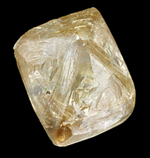|
|
| Formula: | C |  Click to see a larger image |
||
| Crystal: | Isometric | |||
| Hardness: | 10 | |||
| Spec. Gr.: | 3.50-3.53 | |||
| Streak: | N/A | |||
| Cleavage: | Perfect octahedral | |||
| Location: | Mirny, Sakha Republic, Yukutia, Siberia, Russia |
| The diamond has many unique qualities. It is the most valued, widely used, and hardest of all gemstones. Its name is derived from the Greek ADAMAS, invincible. It originates under extreme pressure accompanying the volcanic production of kimberlite whose ingredients are peridot, pyroxene and pyrope. Kimberlite fills vertical pipes that may have diameters hundreds of meters in width. Major sources of diamonds are at Diamantina, Brazil, and the world's largest primary source, Kimberley, South Africa. In 1961 huge deposits similar to Kimberley were found at Mirny, Yakutia, Siberia, Russia. The 18.01 carat crystal in the UCSB Geology Collection occurred at Mirny. Diamonds occur in a wide range of colors: basically white or colorless; "fancies," include golden brown, yellow, blue, green, pink, and amber. |
|
Bibliography: Arem, Joel, Gems and Jewelry. Svenek, Jaroslav, Minerals, 1987, pg. 42-43. |
|
University of California, Santa Barbara—Department of Earth Science Copyright © 2005 Regents of the University of California Send your comments to the Web Page Editor |